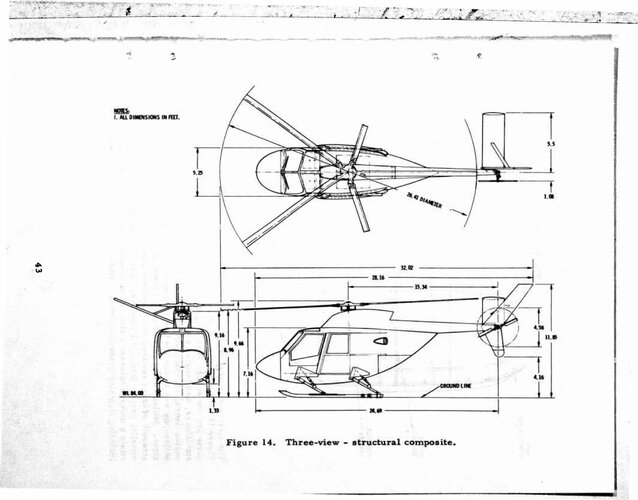Full-Scale Crash Tests of the ACAP Helicopters
Full-scale crash qualification tests were performed of the Bell and Sikorsky Advanced
Composite Airframe Program (ACAP) helicopters in 1987 [38-40]. The purpose of the Army-sponsored
ACAP was to demonstrate the potential of advanced composite materials to save weight and cost in
airframe structures while achieving systems compatibility and meeting military requirements for
vulnerability reduction, reliability, maintainability, and survivability. In 1981, the U.S. Army awarded
separate contracts to Bell Helicopter Textron and Sikorsky Aircraft Company to develop, manufacture,
and test helicopters constructed primarily of advanced composite materials. Each company
manufactured three airframes that were tested under a variety of static and dynamic conditions to
demonstrate compliance with the program objectives. In addition, one helicopter airframe from each
company was equipped to become a flying prototype. Crash tests of the Bell and Sikorsky ACAP static
test articles were conducted in 1987 at the IDRF in support of the U.S. Army AATD to demonstrate
their impact performance and to verify compliance with crash requirements. Pre- and post-test
photographs of the full-scale crash tests are shown in Figure 17. The Bell ACAP helicopter impacted
with a combined 42-fps vertical and 27-fps forward velocity, while the Sikorsky ACAP helicopter
impacted at 39-fps vertical velocity. These tests demonstrated the successful application of composite
materials to save weight and maintenance costs in rotorcraft design, while also achieving improved
crash performance.
In 1998, a research project was initiated to demonstrate the capabilities of state-of-the-art
commercial crash simulation codes in predicting the dynamic structural response of a prototype
composite helicopter, the Sikorsky ACAP helicopter, during a full-scale crash test. A crash simulation
of the full-scale crash test was developed using the commercial nonlinear, explicit transient dynamic
code, MSC.Dytran [52]. The objective of the crash simulation was to evaluate the capabilities of the
code in predicting the response of a composite airframe subjected to impact loading. An existing
NASTRAN [54] modal-vibration model of the Sikorsky ACAP helicopter was modified and converted
into a model suitable for crash simulation. The MSC.Dytran model is shown in Figure 25. A two-stage
modeling approach was implemented for the crash simulation and an external user-defined subroutine
was developed to represent the complex landing gear response. Analytical predictions of structural
deformation and failure, the time sequence of events, and the dynamic response of the airframe structure
were generated. The numerical results were correlated with the experimental data to validate the
simulation [55-58]. The level of agreement obtained between the experimental and analytical data
builds further confidence in the use of nonlinear, explicit transient dynamic finite element codes as a
crashworthy design and certification tool for aircraft.
Full-Scale Crash Test of the Sikorsky ACAP Helicopter (Flight Test Article)
A full-scale crash test of the Sikorsky ACAP helicopter was performed at the IDRF in 1999. The
main purpose of the test was to obtain experimental data for validation of a finite element crash
simulation. The helicopter was the flight test article built by Sikorsky Aircraft under sponsorship by the
U.S. Army during the ACAP. The helicopter was constructed primarily of advanced composite
materials and was designed to meet the Army's stringent MIL-STD-1290A [42] crashworthiness criteria.
For the crash test, the aircraft was outfitted with two crew and two troop seats and four instrumented
anthropomorphic dummies. The test was performed at 38-fps vertical and 32.5-fps horizontal velocity
onto a rigid impact surface [43]. Approximately 120 channels of dynamic data were collected.
Photographs of the helicopter taken just prior to and after impact are shown in Figure 22.
In addition to obtaining structural crash data for validating a nonlinear transient dynamic
computer simulation, several ancillary experiments were included. A programmable electronic crash
sensor unit (ECSU) was mounted on the cabin floor near the troop seats. The sensor was typical of the
kind that might be used to inflate an airbag. During the test, the ECSU operated successfully and was
very helpful in obtaining time synchronization between the exterior and interior cameras. In addition,
the left and right fuel tanks were instrumented with two transducers each to measure the hydrodynamic
pressure pulse during impact. The pilot and copilot dummies were seated in two military-qualified loadlimiting
seats from two different vendors. The troop dummies were seated in ceiling-suspended troop
seats, each with two wire-bender energy absorbers that were mounted in the rear cabin area of the
helicopter. The detailed seat and occupant response data obtained from the crash test were evaluated
and the occupant data were correlated with injury prediction models [44].
A History of Full-Scale Aircraft and Rotorcraft Crash Testing and Simulation at NASA Langley Research Center
http://citeseerx.ist.psu.edu/viewdoc/summary?doi=10.1.1.75.1605




















































